
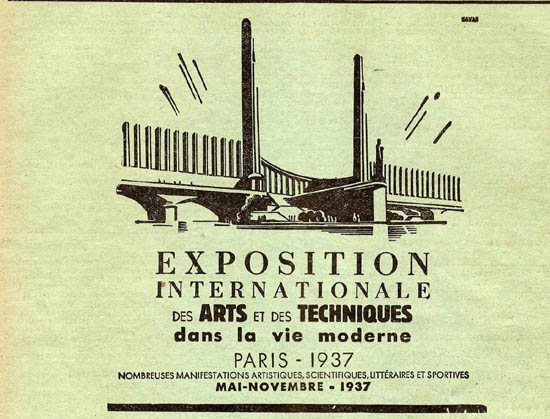


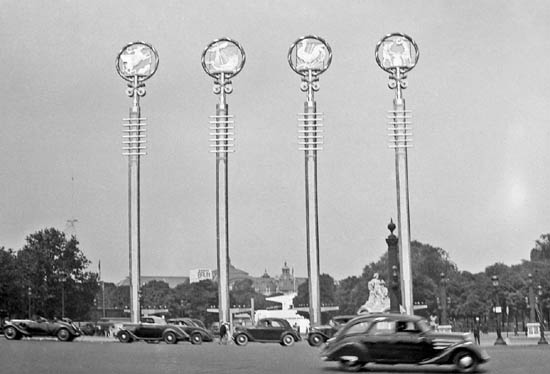
The four monumental emblems set up at the entrance of the exposition symbolized the Arts, Paris, France and Industry. But as it would be difficult not to see in the shape of the emblems the influence of the contemporary German and Italian imperial standards, so the overall picture of the whole exposition was essentially determined by two buildings: the pavilions of Nazi Germany and of the Soviet Union, set up facing each other.


The location of the German and Soviet pavilions in the center of the exposition, opposite each other, was the idea of the French organizers, who – as it is reflected in the contemporary French press – were apparently impressed by the technological development of these two empires in the previous decade. And the two pavilions also appear to intentionally adjust to each other. The central elements of both are a large – 65 and 55 meters high – tower, with a statue on the top: that of the German eagle, and of the Worker and the Kolkhoz Woman, which has since become emblematic.
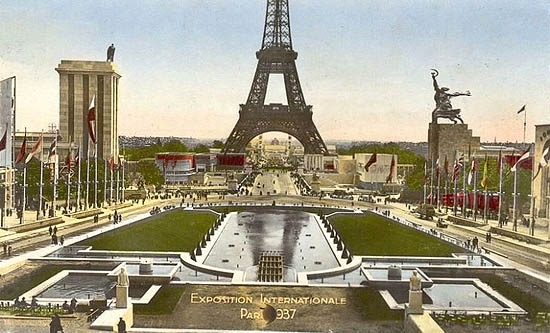
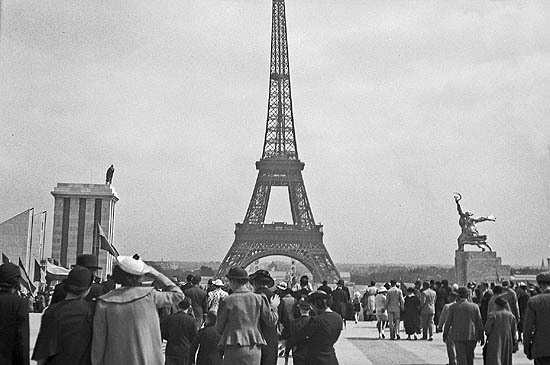
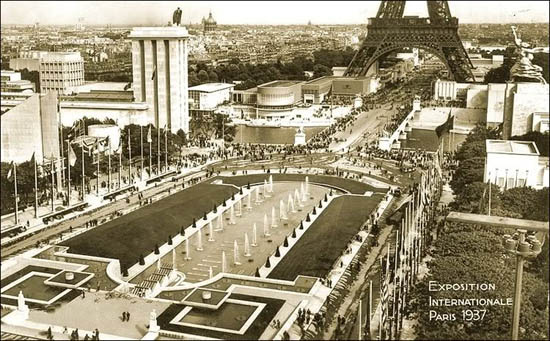
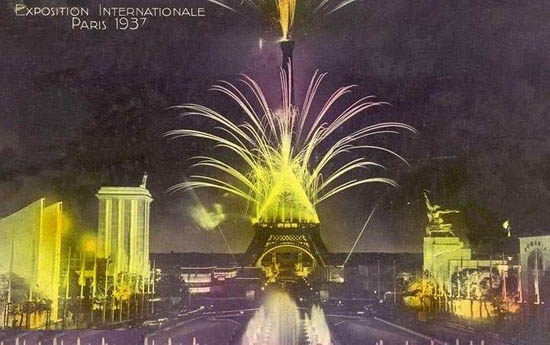
The 150 meters long Soviet pavilion gradually rises on the banks of the Seine. On its highest point – in the words of the sculptor, Vera Mukhina –, there are “a young man and a girl, the owners of the Soviet land, symbols of the working class and the kolkhoz peasantry, raising high the emblem of the Soviet Union, the hammer and sickle”. This sculpture was an integral part of the architectural concept, about which the designer, Boris Iofan wrote:
“In my concept, the Soviet pavilion has to be a triumphantly towering building, which expresses the rapid growth and dynamic achievements of the first socialist country, as well as the enthusiasm and vitality of our great age, the building of socialism… I am convinced that this ideological commitment can be only expressed by a bold blend of architecture and sculpture… I imagined the statue to be made of a bright and light metal, flying straight ahead like the unforgettable Nike, the Winged Victory of the Louvre…”
The building was covered by shiny Samarkand marble, decorated around the entrance at the front side of the tower by I. M. Chaikov with the coat of arms of the Soviet Union and of its – then only – eleven republics, as well as with the allegories of Soviet life. The exhibition was divided into five sections. The first room presented the new Stalinist Constitution – about which we will soon write more –, the second the development of science, industry and economy, presenting the distribution of the forces of production in the country on a 22 m2 large map made of ten thousand semi-precious stones; the third section the arts, with an exhibition room and a four hundred-seat movie theatre; the fourth the development of the North Sea route – which is also waiting for a separate post –, and the fifth the Soviet city planning and the development of modern Soviet cities.
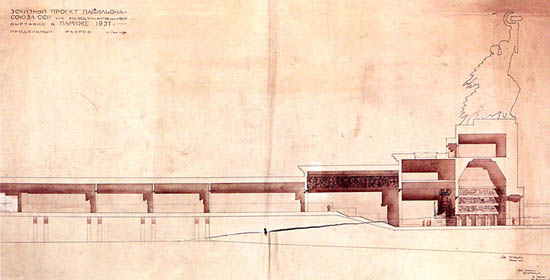

The image of the statue decorated also the recording published in the 20th anniversary of the October Socialist Revolution and in honor of the world exposition, with the final song of the propaganda film Цирк made just a year earlier by Grigory Alexandrov, the Wide is my Motherland, which was taught as a Russian folk song in the compulsory Russian lessons even in the 80s by whoever had such a lesson. Here below it is performed by the legendary Lyubov Orlova, who plays an artiste escaping with her black son from the American racism to the Soviet Union.
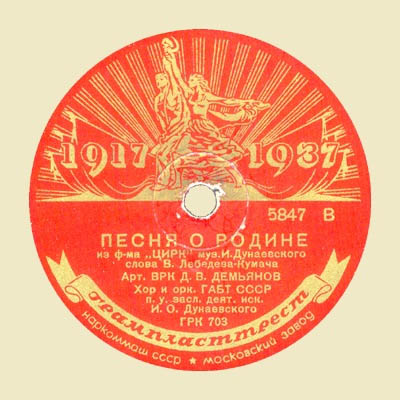
The over ten thousand tons of steel and stone necessary for the German pavilion were shipped on more than a thousan freight cars from Berlin, as the pavilion had to be built “from the sacred German soil” and “only from German iron and stone”. The designer, Albert Speer writes in his memoirs, that he entered accidentally the site where the Soviet pavilion was prepared, and on the basis of what he saw there, he amended his plans so that the static block of the German pavilion visually breaks the dynamism of the Soviet one running against it, and towers above it. The sculptural decoration was also here an important element in the architectural concept. The building was crowned by Kurt Schmid-Ehmen’s eagle holding a swastika, and on either side of the entrance there stood two compositions, the Comradeship and Family of the star sculptor of the Third Reich, Josef Thorak.
The three light projections of the pavilion forming a Roman number III not only referred to the Third Reich, but gave shape for the first time to Speer’s idea of the “Lichtdom”, the building made of pure light, whose final, mature form will be realized by him for the Nuremberg Party Day in the following year. The German pavilion of the world exposition dedicated to the light and progress rose up in the night, from dusk till dawn, as a disembodied building of light, outshining all the other lights of the ville des lumières, not only the Soviet pavilion, but the Eiffel Tower as well.
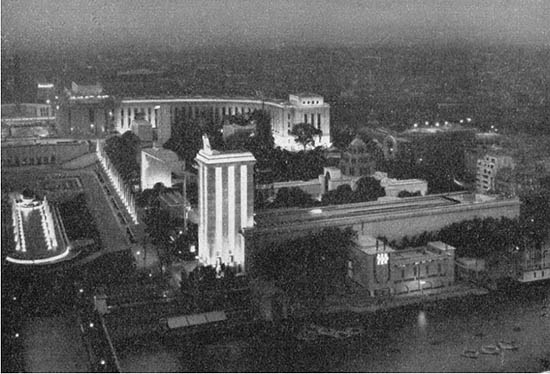

Besides the formal parallels, there are also other similarities between the two pavilions. First of all, that both of them were designed by the leading architect and sculptor of the respective country. For a better understanding of their symbolism, it is worth seeing who these people were, and which achievements were behind them.
Boris Iofan (1891-1976) was a leading figure of the Stalinist architecture of the 30s and 40s. Born in a Jewish family in Odessa, after his St. Petersburg studies he graduated in architecture in Rome in 1916. He returned to the Soviet Union in 1924, by when he had fully mastered the Neoclassical idiom, which would become the common ground for the architecture of the totalitarian Italy, Germany and Soviet Union.
His first major work in Moscow was the functionary house opposite the Kremlin, called since Trifonov’s novel just “the house on the quay”, the last constructivist and first Stalinist building, from which the residents disappeared in line, only Boris Iofan stayed there until his death. His fame, however, was based in 1931 by the contest of the Palace of Soviets intended on the place of the blown-up cathedral of Christ the Saviour, about which we wrote earlier, and where he was chosen as a winner by Stalin himself. A central element of the plan, the statue of Lenin standing on the top of the building as on a pedestal, particularly won Stalin’s pleasure, thus starting a new trend in the Soviet architecture, also followed by Iofan himself in his pavilions for the 1937 and 1939 world expositions.

Vera Mukhina (1889-1953), the creator of the statue of the Worker and Kolkhoz Woman, which has since become emblematic, was born in an upper middle-class family in Riga, and studied first in Moscow, then in Paris with Antoine Bourdelle, assistant of Rodin. She returned shortly before the First World War to Russia, where he became a follower of Lenin. In 1919 she created the constructivist statue “The Flame of the Revolution”, which made her a favorite of People’s Commisar of Education Lunacharsky, and brought her a number of important commissions. By the 1930s she became one of the leading sculptors of the Soviet Union. In 1937 she was accused that Trotsky’s facial features were outlined in the Kolkhoz Woman’s waving scarf, but the supreme leadership acquitted her of the charges. Indeed, as a result of the great success, the statue made only for the period of the world exposition was set up on a permanent place in Moscow, and it became the well-known emblem of the Mosfilm. And during its restoration in 2010 even the Iofan’s pedestal of 1937 was reconstructed underneath.

Albert Speer (1905-1981) became a convinced Nazi back in 1930, on hearing Hitler’s and Goebbel’s speeches. After his works done for the Berlin district leader of the party Karl Hanke he received increasingly important orders, until in 1933 he became a member of Hitler’s inner circle, and his adviser in matters of architecture. The following year, after the death of Paul Troost, he became the party’s chief archictect. As such, he designed the Nuremberg Zeppelinfield stadium, the scene of the rallies of the party – as well as of Leni Riefenstahl’s propaganda films –, in 1937 the German Pavilion, and in the following year the New Reich Chancellery, his largest completed building. Meanwhile, they steadily worked together with Hitler on the transformation of Berlin into a monumental capital called “Germania”. Due to his excellent organizational skills, in 1942 he was appointed Minister of Armaments and War Production. In Nuremberg he was sentenced to twenty years in prison. He was released in 1966. His memoirs, published after this date, are a unique source of the Nazi era.

Josef Thorak (1889-1952) became widely known due to his monumental WWI memorials. In 1933 he became, together with Arno Breker, an official sculptor of the Third Reich, creator of gigantic sculptures, after having divorced, to this end, from his Jewish wife, who along with their son was declared missing after the war. He designed the sculptural decoration of the 1936 Berlin Olympic Hall as well as of most buildings of Albert Speer. A number of his public sculptures still stand in Berlin. The process of denazification declared him innocent, and until his death in 1952 he had various exhibitions.

However, this list would not be complete without the names of two people, who always stood behind the process of creation, and to some extent even took part in it, and whose aspirations are expressed by the two buildings – as well as by their opposition.
Stalin and Hitler both saw clearly how much the monumental architecture became the most important branch of art and propaganda tool of the age. Both of them inherited a provincial-looking capital, which they tried with huge efforts to transform into a metropolis expressing the greatness of the empire. History left only a short time to Hitler to build his Germania, and much of what was actually realized of it, was destroyed by the war, but Stalin was also not given to complete the new Moscow defined by the Eight Sisters and the Palace of Soviets standing in their center. However, their ideas and the works of the architects supported by them defined for a long time the architecture of the two countries and later of the whole Eastern Europe. We have already written and will also write about this in detail, but for a first comprehensive picture it is worth to watch Ilya Bogdanov’s documentary film Серп против свастики. Схватка гигантов (Sickle against Swastika. Struggle of Giants, 2012), which, setting out precisely from the world exposition of 1937, presents with a rich contemporary visual material the architectural efforts of the two totalitarian systems.
The Trocadero, defined by the central buildings of the two empires, also hosted most pavilions of the other, mainly European countries – in an ominous way, Poland and Spain in the imminent shadow of the Germanian pavilon, while Hungary and Romania in that of the Soviet one. On the other side of the Seine, a romantic little town embracing the French provinces, and on the island of the Seine, the pavilions of the French colonies.
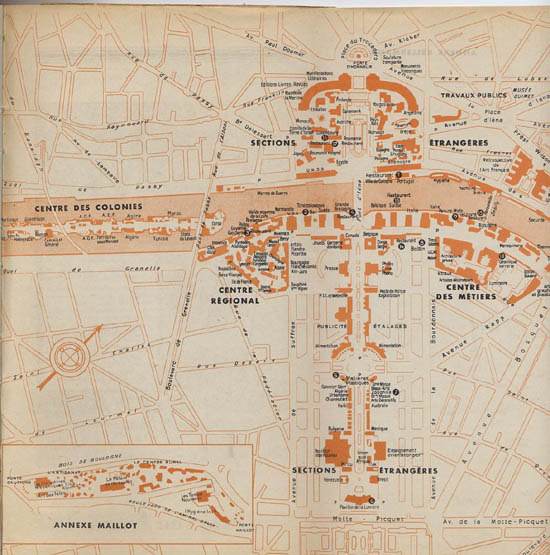
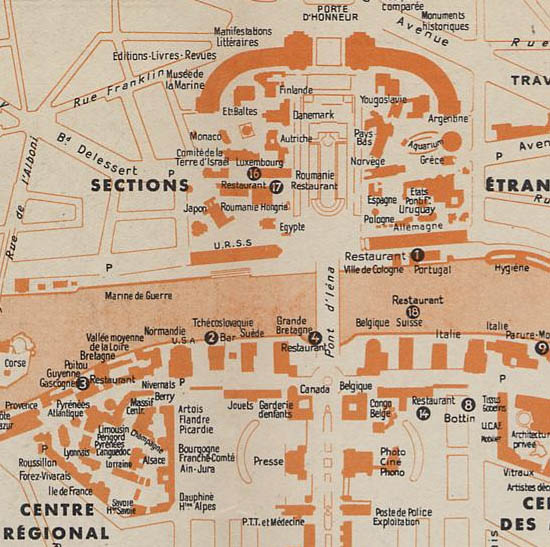

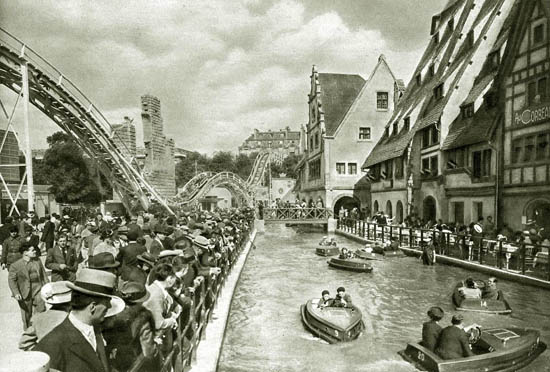

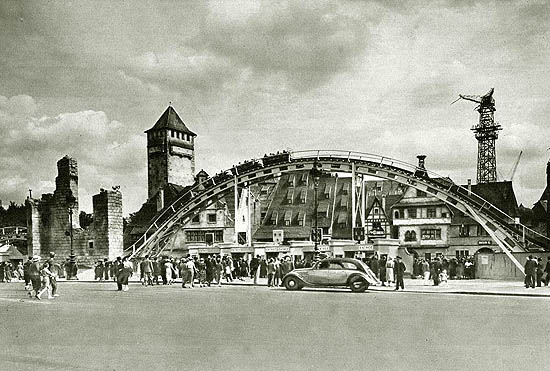
Another series has popped up recently on the Russian net, made on the world exposition by the sons of the great photographer-inventor of the turn of the century, Sergei Prokudin-Gorsky, Dmitry and Mikhail.

These pavilions, even if they use one or another monumental element of modern architecture, basically try to display the ethnic or exotic features of the respective country – as Philip Walen points it out in his study on the pavilions of the French provinces –, extending as a sleepy, peaceful Europe, living its own small-town life, in the menacing shadow of the twin towers. The Soviet and German pavilions were awarded the shared first prize of the exposition, plus more than five hundred grand prizes, medals and diplomas. The exhibited model of Boris Iofan’s Palace of Soviets received a special grand prize. And at the opening ceremony the Minister of Development expressed the hope that the German presence in the exposition will strengthen the relations between the two nations.
There is only one building that differs from the others, the pavilion of Spain, also presented in the above video. In front of it, Alberto Sánchez’s sculpture, resembling a burnt tree. On the facade, one photograph and its caption about the million of armed soldiers standing in the trenches. Inside, a minimalist stage design, just a small round fountain of mercury by Alexander Calder in the middle of the plundered Spanish patio, in memory of the siege of Almadén, and at the end of the patio, Picasso’s Guernica, painted for the occasion. Beside the towers of the two empires, this is the only building which foreshadows what waits less than two years later for Europe.
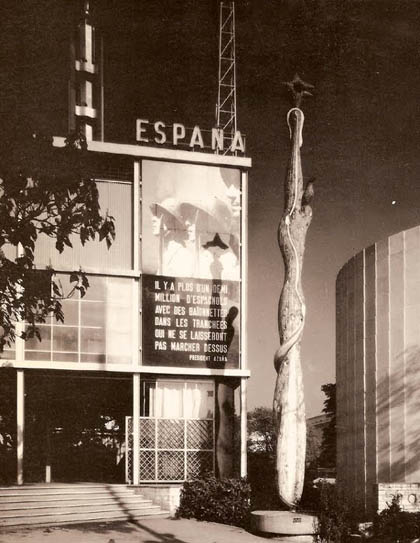
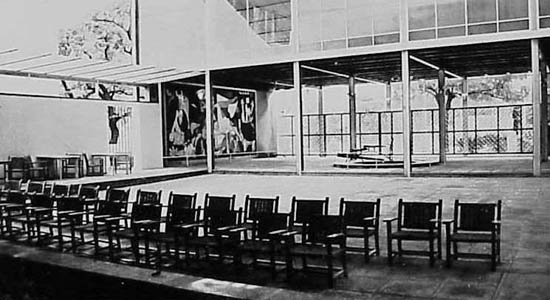
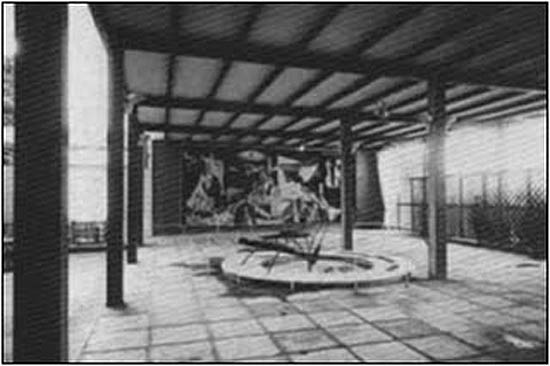
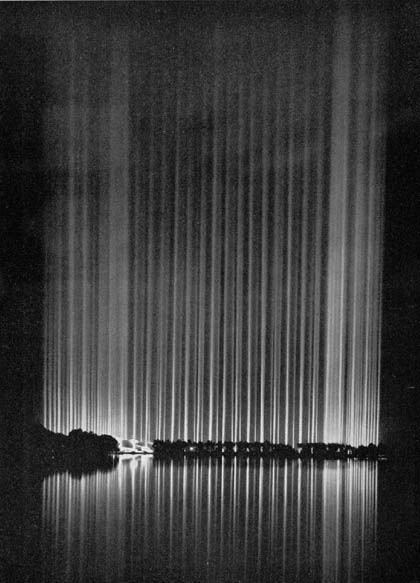
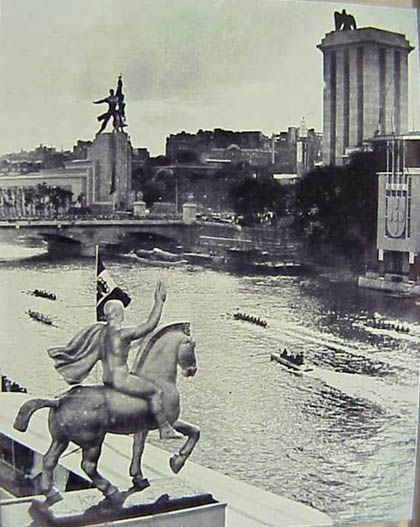

























































4 comentarios:
A replica of the Spanish pavilion stands in Barcelona and currently hosts a library with a collection on the Spanish second republic and civil war.
The official website reports that the sculpture originally in front of the original pavilion was not by Miró but rather by Alberto Sánchez, and was entitled El pueblo español tiene un camino que conduce a una estrella.
What looks like a round pool inside is another sculpture, Alexander Calder's Mercury Fountain. This (or possibly a replica) is also extant in Barcelona, though not in the replica pavilion but in the Miró Museum. It is perhaps unintentionally ironic and fitting that the original pavilion would greet its visitors with a toxic pool.
What an amazing post! I love history and Paris and maps, and I'll be poring over this for a while. Many thanks (as always).
And (as always) a nitpick: take the "the" away from "the Nazi Germany," where it's out of place, and add it to the title, which needs it: "Before the Storm."
There's a nice post on the Exposition here:
http://www.bibliobuffet.com/on-marking-books-columns-195/archive-index-on-marking-books/560-the-year-of-politics-and-art-111807
And the section on it in Piers Brendon's excellent The Dark Valley: A Panorama of the 1930s is well worth reading (it's the start of chapter XXIII); here are a few excerpts:
"The Nazis, though, won the contest for architectural virility. This was not only because of their seven-metre statues of 'aggressively nude Teutons' (before whose prodigious loins amused spectators would photograph one another) but because the German eagle clutching the swastika overshadowed the hammer and sickle opposite. The juxtaposition gave rise to conflicting myths: an inhabitant of affluent Passy 'distinctly saw' the eagle flying off with the Soviet emblems in its talons; but a resident of 'Red' Bobigny, 'better informed about the tricks of aerial perspective,' plainly witnessed 'the sickle cutting off the eagle's wings.'" ...
"Moreover, something of the essence of Stalin's Russia was captured by a fresco in the Great Hall portraying the old Bolshevik leaders. As they disappeared into the maw of the NKVD, frantic last-minute efforts were made to disguise the purges 'by adding, for instance, a beard to Marshal Tukhachevsky's face, sideburns to Radek, hair to Zinoviev.'" ...
"Even as it was being erected the Exposition became a focus for the industrial strife which had plagued France since the advent of the Popular Front. Convinced that they were being exploited and worried about unemployment once the work was done, the 20,000 builders spun out their tasks, restricted overtime and periodically went on strike. [...] The official opening had to be postponed. Even when it did take place, on 25 May 1937, most pavilions were unfinished, though, Parisians joked, 'The Eiffel Tower is ready.' So, embarrassingly enough, were the edifices constructed by the totalitarian powers, Germany, Italy and the Soviet Union. [...] Elaborate efforts were made to hide the incompleteness, including the copious use of plasterboard and whitewash. But nothing could prevent visitors from seeing that America's skyscraper was only one storey high."
Thanks, Giacomo. I have corrected the authorship, added the links, and will include your information in a note in all versions.
Thank you, Language, for the corrections, and the excellent literature. I did not know Brendon’s Dark Valley: I surely have to read it.
Publicar un comentario